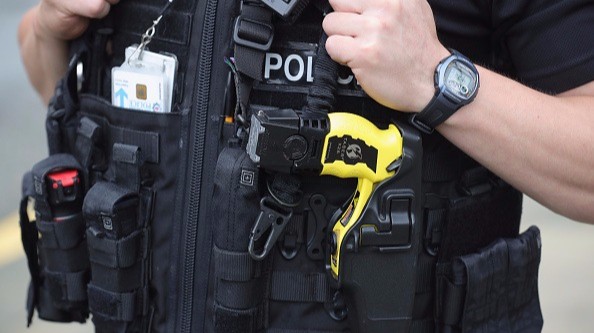(NBC NEWS) -- Three black men were shot dead by police in the past week, marking the latest flash points in violence that touched both coasts and cut through the Midwest.
But in two of those cases — first in Tulsa, Oklahoma, and then in El Cajon, California — not all police on the scene had their guns raised. Officers had Tasers or stun guns, ready too. That raises a familiar question often asked about deadly police confrontations: If officers have less lethal weapons in their arsenal, why wouldn't they use them?
Officers are trained to 'shoot to kill'
Much of policing involves a series of judgment calls made while adrenaline is kicking. And so experts say police officers are trained to assess whether they feel an interaction with a citizen could turn deadly. If tensions reach that point, officers are told the use of lethal force would then be warranted.
"Tasers are not for deadly force situations," said Eugene O'Donnell, a professor at the John Jay College of Criminal Justice. "The only time the police need to be shooting is when there is an absolute matter between life and death. It's not a tool for apprehension."
Experts acknowledge the temptation to train police to shoot to wound, rather than to kill. Why not subdue a suspect by shooting them in the arm or the leg, but not the chest?
The problem is that aiming for a person's limbs can be exceptionally difficult, especially if a suspect is moving, which is often the case. And these altercations typically happen in high-stress environments — an officer's aim may not be as sharp as when they train in the shooting range.
Related: Oklahoma Man Fatally Shot by Deputy Who Meant to Fire Taser
Officers instead are trained to aim toward the chest area to improve chances of actually hitting their target. It doesn't necessarily mean officers are expressly aiming to kill.
There's added pressure in this situation if the suspect has a weapon, especially a gun. Shooting them in the leg isn't going to eliminate the chance that the suspect can still fire back.
William Terrill, a criminology professor at Arizona State University, said police departments don't train cadets to reach for their Taser when they find that an imminent threat is near.
"If you were to respond with less force, it will put you in danger or another citizen in danger," he said.
Tasers aren't always ideal or consistently non-lethal
Policies on deadly or less-lethal force vary widely between states and police departments, as do standard practices on Taser guns. Not every police officer on the street is certified to use stun guns. And while some police departments, like Chicago, are adding hundreds of more Tasers in the field, others only have enough equipment to outfit a fraction of their force.
But there are still downfalls to using the technology. Mainly, Tasers are not always reliable.
"So many shootings involve an inefficient Taser first," said Peter Moskos, a former Baltimore police officer and professor at the John Jay College of Criminal Justice. "They often don't work, and then what?"
From a practical perspective, police officers need to be within a relative mid-range, as far as 15 and 25 feet, in order to use a Taser. But if a subject is too close, then a Taser wouldn't be effective either.
Tasers can also be just as deadly as a gun if certain circumstances align. For people with heart problems or serious medical conditions, as many as 50,000 volts in a single shot from a Taser could turn fatal.A Kansas City teenager went into cardiac arrest after a police officer shot him in the chest with a Taser during a traffic stop in 2014. The 17-year-old nearly died from the incident. On Tuesday, he filed a lawsuit against the weapon's manufacturer and the Independence Police Department, alleging that he suffered from traumatic brain injury out of the ordeal that continues to affect his memory.
Officers have legal leeway in using force that could be deadly
A 1989 Supreme Court case plotted out the parameters in which police could justify using deadly or excessive force. The outcome of Graham v. Connor ultimately decided that the circumstances must be objectively reasonable at the time of the incident in order to warrant excessive force. Oftentimes, the standard is boiled down to the simple question: Was the officer reasonably afraid for their life when the pulled the trigger?
"It's subjective," Terrill said. "It gets very hazy if someone has a gun, but they are not pointing it at an officer."
It's particularly tricky with cases like what happened in El Cajon this week when police approached a man who they say was acting erratically. Police said Alfred Olango, 38, pulled an object out of his pocket, leaning his arms and body forward in a "shooting stance." The police on the scene reacted as though he was holding a gun.


